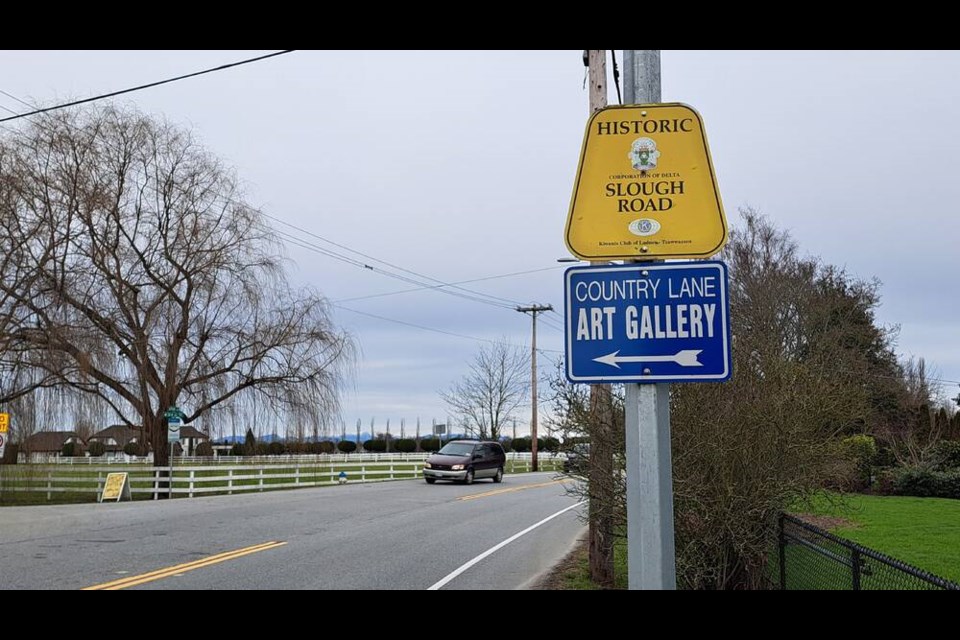Back in time, the Chilukthan Slough ran fuller, farther, and faster, all the way from what was to become Ladner Village, then south and west through marshes and across estuaries, and out to the Pacific.
Though it narrows to the width of a ditch a few km from south arm of the Fraser River, the slough once helped people move around the area.
“At one time, it was wide enough for a rowboat or canoe or something to go up it,” said Anne Murray, who wrote the book, Tracing Our Past: A Heritage Guide to Boundary Bay.
In her book, she describes the Chilukthan as a wide creek that ran from the Fraser River “and entered the sea at Tsawwassen Reserve.
“It used to be a lot larger. It used to be navigable by canoe, so it’s turned into a little bit of a ditch now really,” Murray said.
In her book, she notes that flood-control measures built in the 1860s reduced the flow in the southern stretches, something compounded with the flood of 1894 when the Fraser River’s main arm moved northward.
“In the old days, the salmon would come up into all those sloughs, very much so. That would be a major part of the natural life of the estuary,” Murray said.
And according to the City of Delta, indigenous people used the slough to move between the Fraser River and Boundary Bay, and even small steamboats shipped farm produce on the slough.
Today, somewhat diminished, the meandering watercourse that winds through farmland and enriches the quaint Ladner Village, is a workhorse.
While it drains the village area and provides flood protection, it irrigates precious food crops, feeds waterfowl, and gives shady places for all to rest during scorching summers.
It may have seen better days, but the Chilukthan is stable.
And that’s just how Valerie Fuller would like it to stay.
“I’d just like to see it remain the way it is,” said Fuller, with the Delta Naturalists Society. “It’s very productive the way it is. Leave it as natural as possible.”
She’s lived along the slough for years, with the slough at the back of her yard bringing a steady wildlife show, such as wood ducks which people think they can only see at the George C. Reifel Migratory Bird Sanctuary.
“But in the recent (Ladner) Christmas Bird Count, I had half as many as Reifel did. Reifel had 18. I had nine in my back yard,” said Fuller. “It’s very productive in terms of wildlife.”
To protect it, minimizing development is key, Fuller says.
Years ago, she opposed a plan to put a walkway on one side of the slough, adjacent to farm fields.
“Because as soon as we open areas like this up to the public, it winds up full of garbage. It’s bad for the wildlife,” she said.
That’s what happened when pathways were opened beside sloughs in Richmond, she pointed out.
“Any development along a slough or any waterway really is detrimental to the production of insects and birds and fish and mammals,” she said.
The City of Delta’s Streamside Protection and Enhancement Area, protects the slough by banning any building near the stream bank.
Suman Shergill, engineering director with the city, said the area applies to all land within 30 metres of the top of bank of the Chilukthan.
Any new building must take place outside that area, unless offsetting habitat compensation and provincial approval is given.
Buildings within that setback that predate the bylaw, are grandfathered, which means they can remain.
The slough is indispensable to the farms that surround it.
“It’s 100 per cent critical for all the farmers,” in the area, said Peter Guichon, a local farmer and director with the Delta Farmers Institute.
He also wants the slough to remain as it is and for it to be maintained and kept clear of debris so it can deliver water to local fields, noting in some areas clearing the slough is difficult because of trees and houses close to the water.
“The Chilukthan Slough is really critical to west Delta,” he said.
Still, the City of Delta and the DFI are working well together maintaining the slough, while Fisheries has its own rules which they have to follow, he added.
“Delta’s done a good job,” he said.
For the city, the Chilukthan is a “dual-purpose watercourse,” that’s served Ladner’s residential and farming area for more than a century.
“In winter, the slough provides flood resiliency by draining stormwater runoff from Ladner Village and the surrounding area,” said Steven Lan, general manager, engineering, with the City of Delta. In summer, the slough is one of the main water sources for farms.
The city though is continuously working on enhancing the slough’s environmental benefits, he added.
Recently, Delta improved stream-side and aquatic habitat along the upper slough, near 34B Avenue, in conjunction with Ducks Unlimited.
“Delta will continue to work on enhancement projects along the slough as opportunities arise,” Lan said by email.
The slough also is considered fish habitat and protected under the Fisheries Act, says Fisheries and Oceans Canada.
Media relations advisor Leri Davies, said fish, including young salmon, likely enter the slough during springtime, under certain tidal and flow conditions.
However, water quality for fish can be poor behind flood control gates because of low flows, high temperatures and low oxygen levels, while fish passage can be limited.
Fisheries and Oceans Canada is working on a long-term plan to improve flood gates in the Fraser Valley. Chilukthan Slough is part of that but there are no immediate plans for any improvement, Davies said by email.
“Hopefully, they’ll keep it as a slough,” but natural processes could take effect, said Murray.
“It’s definitely got a long history and connection with the whole Ladner area. It’s just a key part of it,” although many people who know the details and stories have gone, she added.



